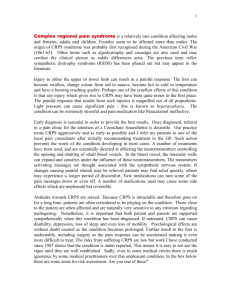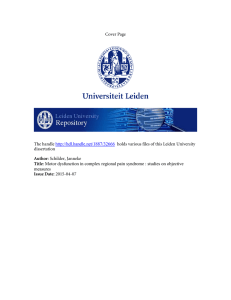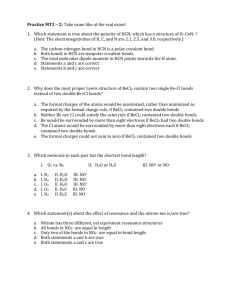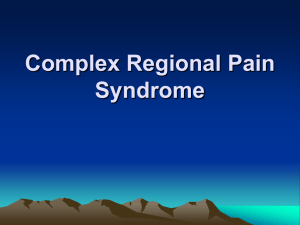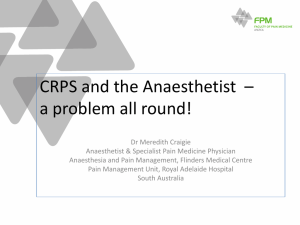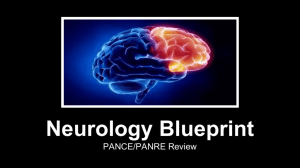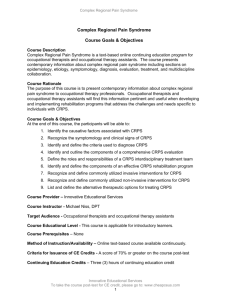RSD/CRPS: The end of the beginning (editorial)
advertisement
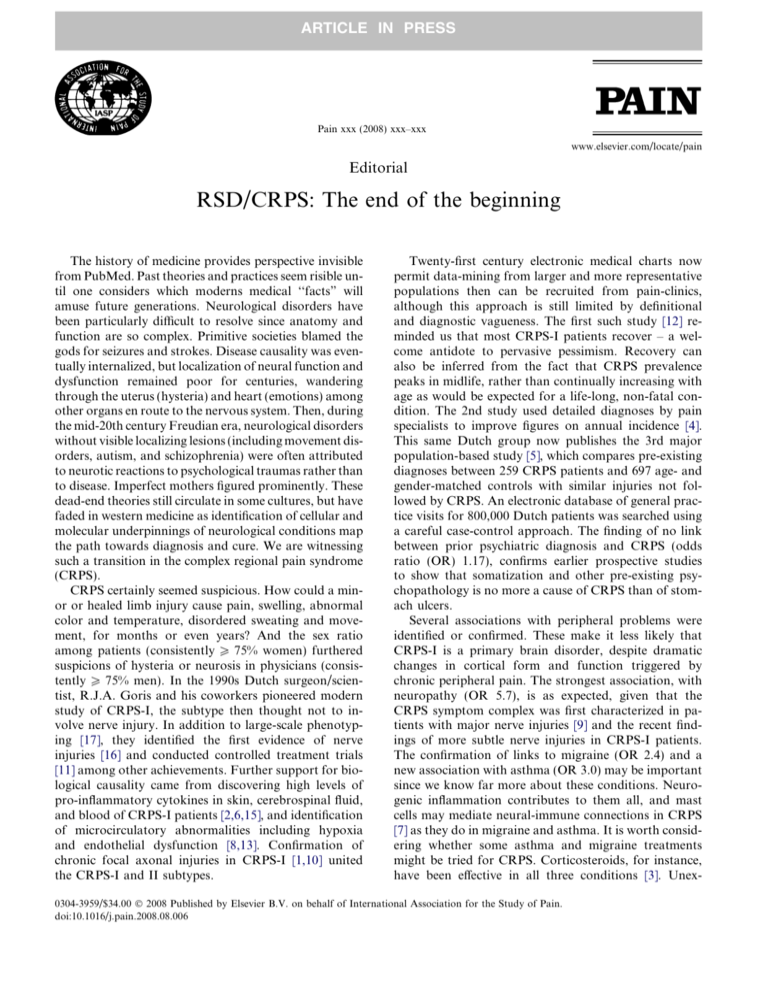
ARTICLE IN PRESS Pain xxx (2008) xxx–xxx www.elsevier.com/locate/pain Editorial RSD/CRPS: The end of the beginning The history of medicine provides perspective invisible from PubMed. Past theories and practices seem risible until one considers which moderns medical ‘‘facts” will amuse future generations. Neurological disorders have been particularly difficult to resolve since anatomy and function are so complex. Primitive societies blamed the gods for seizures and strokes. Disease causality was eventually internalized, but localization of neural function and dysfunction remained poor for centuries, wandering through the uterus (hysteria) and heart (emotions) among other organs en route to the nervous system. Then, during the mid-20th century Freudian era, neurological disorders without visible localizing lesions (including movement disorders, autism, and schizophrenia) were often attributed to neurotic reactions to psychological traumas rather than to disease. Imperfect mothers figured prominently. These dead-end theories still circulate in some cultures, but have faded in western medicine as identification of cellular and molecular underpinnings of neurological conditions map the path towards diagnosis and cure. We are witnessing such a transition in the complex regional pain syndrome (CRPS). CRPS certainly seemed suspicious. How could a minor or healed limb injury cause pain, swelling, abnormal color and temperature, disordered sweating and movement, for months or even years? And the sex ratio among patients (consistently P 75% women) furthered suspicions of hysteria or neurosis in physicians (consistently P 75% men). In the 1990s Dutch surgeon/scientist, R.J.A. Goris and his coworkers pioneered modern study of CRPS-I, the subtype then thought not to involve nerve injury. In addition to large-scale phenotyping [17], they identified the first evidence of nerve injuries [16] and conducted controlled treatment trials [11] among other achievements. Further support for biological causality came from discovering high levels of pro-inflammatory cytokines in skin, cerebrospinal fluid, and blood of CRPS-I patients [2,6,15], and identification of microcirculatory abnormalities including hypoxia and endothelial dysfunction [8,13]. Confirmation of chronic focal axonal injuries in CRPS-I [1,10] united the CRPS-I and II subtypes. Twenty-first century electronic medical charts now permit data-mining from larger and more representative populations then can be recruited from pain-clinics, although this approach is still limited by definitional and diagnostic vagueness. The first such study [12] reminded us that most CRPS-I patients recover – a welcome antidote to pervasive pessimism. Recovery can also be inferred from the fact that CRPS prevalence peaks in midlife, rather than continually increasing with age as would be expected for a life-long, non-fatal condition. The 2nd study used detailed diagnoses by pain specialists to improve figures on annual incidence [4]. This same Dutch group now publishes the 3rd major population-based study [5], which compares pre-existing diagnoses between 259 CRPS patients and 697 age- and gender-matched controls with similar injuries not followed by CRPS. An electronic database of general practice visits for 800,000 Dutch patients was searched using a careful case-control approach. The finding of no link between prior psychiatric diagnosis and CRPS (odds ratio (OR) 1.17), confirms earlier prospective studies to show that somatization and other pre-existing psychopathology is no more a cause of CRPS than of stomach ulcers. Several associations with peripheral problems were identified or confirmed. These make it less likely that CRPS-I is a primary brain disorder, despite dramatic changes in cortical form and function triggered by chronic peripheral pain. The strongest association, with neuropathy (OR 5.7), is as expected, given that the CRPS symptom complex was first characterized in patients with major nerve injuries [9] and the recent findings of more subtle nerve injuries in CRPS-I patients. The confirmation of links to migraine (OR 2.4) and a new association with asthma (OR 3.0) may be important since we know far more about these conditions. Neurogenic inflammation contributes to them all, and mast cells may mediate neural-immune connections in CRPS [7] as they do in migraine and asthma. It is worth considering whether some asthma and migraine treatments might be tried for CRPS. Corticosteroids, for instance, have been effective in all three conditions [3]. Unex- 0304-3959/$34.00 Ó 2008 Published by Elsevier B.V. on behalf of International Association for the Study of Pain. doi:10.1016/j.pain.2008.08.006 ARTICLE IN PRESS 2 Editorial / Pain xxx (2008) xxx–xxx pected associations with menstrual disorders (OR 2.6) and osteoporosis (OR 2.4) should spark further study. De Mos et al. have identified new clinical links to CRPS and validated findings that implicate inflammation, vasodysregulation, and axonal injury in CRPS pathogenesis. The challenge now is to learn how these interact, because each can lead to the other, like the chicken and the egg. For instance, distal axons are exquisitely vulnerable to energy deprivation, so vasodysregulation or inflammation can trigger axonopathy. My working hypothesis is that although specific patients may enter the CRPS rotary from different points, malfunctioning small-fiber axons are central. Somatic and autonomic small-fibers densely innervate and regulate tissues to maintain homeostasis. In CPRS, even subtle axonal injuries appear sufficient to trigger remaining fibers into inappropriate firing and neuropeptide release. This combination suffices to cause chronic pain, vasodysregulation, neurogenic inflammation as well as changes in innervated tissues. Then, too much or too little small-fiber afferent input can wreak additional havoc among central neurons and glia. But epidemiological and biological research is entirely dependent upon careful characterization and diagnosis of individual patients by physicians. This has been notoriously lax in CRPS. Acceptance of CRPS as a neuropathic pain syndrome would provide new framework and rigor. Applying the recently proposed revised definition of neuropathic pain as ‘‘pain arising as a direct consequence of a lesion or disease affecting the somatosensory system” [14] would reduce the number of patients without trauma, illness, or lesion being erroneously diagnosed with CRPS. Classifying diagnoses as ‘‘definite, probable, or possible” according to the strength of objective evidence permits different levels of certainty to be applied as needed in clinical and research settings. It also conforms to clinical practice and to classification strategies proven useful in other diseases. In the beginning, asthma too was thought to have strong psychological antecedents, but unraveling asthma biology is what led to effective treatments. CRPS research initiated and continued by Dutch scientists has brought us to the end of the beginning in understanding CRPS, and offers hope for the beginning of the end. Acknowledgements Supported in part by grants from the National Institutes of Health (R01NS42866, K24NS059892). References [1] Albrecht PJ, Hines S, Eisenberg E, Pud D, Finlay DR, Connolly MK, et al. Pathologic alterations of cutaneous innervation and vasculature in affected limbs from patients with complex regional pain syndrome. Pain 2006;120:244–66. [2] Alexander GM, van Rijn MA, van Hilten JJ, Perreault MJ, Schwartzman RJ. Changes in cerebrospinal fluid levels of proinflammatory cytokines in CRPS. Pain 2005;116:213–9. [3] Christensen K, Jensen EM, Noer I. The reflex dystrophy syndrome response to treatment with systemic corticosteroids. Acta Chir Scand 1982;148:653–5. [4] de Mos M, de Bruijn AGJ, Huygen FJPM, Dieleman JP, Stricker BHC, Sturkenboom MCJM. The incidence of complex regional pain syndrome: A population-based study. Pain 2007;129:12–20. [5] de Mos M, Huygen FJPM, Dieleman JP, Koopman JSHA, Stricker BHC, Sturkenboom MCJM. Medical history and the onset of complex regional pain syndrome (CRPS). Pain, 2008, doi:10.1016/j.pain.2008.07.002.. [6] Huygen FJ, De Bruijn AG, De Bruin MT, Groeneweg JG, Klein J, Zijistra FJ. Evidence for local inflammation in complex regional pain syndrome type 1. Mediators Inflamm 2002;11:47–51. [7] Huygen FJPM, Ramdhani N, van Toorenenbergen A, Klein J, Zijlstra FJ, Zijlstra FJ. Mast cells are involved in inflammatory reactions during complex regional pain syndrome type 1. Immunol Lett 2004;91:147–54. [8] Koban M, Leis S, Schultze-Mosgau S, Birklein F. Tissue hypoxia in complex regional pain syndrome. Pain 2003;104: 149–57. [9] Mitchell SW. Injuries of nerves and their consequences. New York: Dover Publications, Injuries of nerves and their consequences; 1864. [10] Oaklander AL, Rissmiller JG, Gelman LB, Zheng L, Chang Y, Gott R. Evidence of focal small-fiber axonal degeneration in complex regional pain syndrome-I (reflex sympathetic dystrophy). Pain 2006;120:235–43. [11] Oerlemans HM, Oostendorp RA, de Boo T, Goris RJ. Pain and reduced mobility in complex regional pain syndrome I: outcome of a prospective randomised controlled clinical trial of adjuvant physical therapy versus occupational therapy. Pain 1999;83:77–83. [12] Sandroni P, Benrud-Larson LM, McClelland RL, Low PA. Complex regional pain syndrome type I: incidence and prevalence in Olmsted county, a population-based study. Pain 2003;103: 199–207. [13] Schattschneider J, Hartung K, Stengel M, Ludwig J, Binder A, Wasner G, et al. Endothelial dysfunction in cold type complex regional pain syndrome. Neurology 2006;67:673–5. [14] Treede RD, Jensen TS, Campbell JN, Cruccu G, Dostrovsky JO, Griffin JW, et al. Neuropathic pain. Redefinition and a grading system for clinical and research purposes. Neurology 2008;70:1630–5. [15] Uceyler N, Eberle T, Rolke R, Birklein F, Sommer C. Differential expression patterns of cytokines in complex regional pain syndrome. Pain 2007;132:195–205. [16] van der Laan L, ter Laak HJ, Gabreels-Festen A, Gabreels F, Goris RJ. Complex regional pain syndrome type I (RSD): pathology of skeletal muscle and peripheral nerve. Neurology 1998;51: 20–5. [17] Veldman PH, Reynen HM, Arntz IE, Goris RJ. Signs and symptoms of reflex sympathetic dystrophy: prospective study of 829 patients. Lancet 1993;342:1012–6. Anne Louise Oaklander Departments of Neurology and Pathology, Massachusetts General Hospital, Harvard Medical School, 275 Charles Street, Warren 310 mailbox; Boston; MA 02114; USA Tel.: +1 617 726 4656; fax: +1 617 726 0473 E-mail address: aoaklander@partners.org
